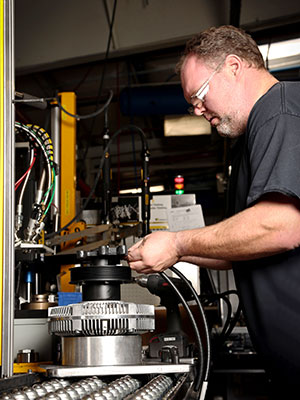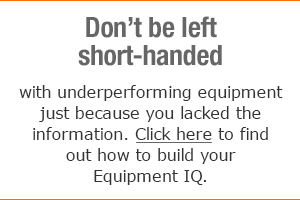Senior Reporter
Horton to Launch New Emissions-Cutting Fan Drives, Blades

ROSEVILLE, Minn. — Horton Holding Inc. will launch in September new variable-speed fan drives and fan blades designed to improve commercial vehicle cooling system performance and help engine makers meet the increasingly stringent requirements in Phase 2 of the federal greenhouse-gas regulations.
The company made the announcement during a media tour of its headquarters here and its production plant in Britton, S.D., July 18-19.
“What we do is innovate. That’s what the company was founded on. We spend all our energy on it,” CEO Cordell Dietz said.

An employee at Horton's Britton, S.D., plant puts the finishes touches on the RCV250 Fan Drive. (Horton Holding Inc.)
“You won’t see Horton getting distracted by technologies in other areas and try to be a shop that does so many different things that we are not great at one thing,” Dietz said. “We want to be great at one thing — now that one thing extends into a lot of different marketplaces.”
Horton’s new LCX Series of variable-speed fan drives adds three new features to its existing variable-speed design: faster cold-start disengagement, a lower off-speed and optimized low-speed controllability.
Variable-speed fan drives rotate the fan at a wider range of speeds, compared with simply on-off, to more precisely match actual cooling requirements — and thereby reduce fuel consumption, noise and parasitic drag on the engine.
Horton’s Cold-Start Disengagement is a proprietary feature that disengages the LCX Series Fan Drives as much as 80% quicker than the closest competitor, according to the company — allowing engines and cabs to warm up faster during cold weather starts, saving fuel and reducing associated emissions and noise.
Low off-speed in a fan drive means little energy is consumed by the spinning of the fan during times when cooling is not needed. The LCX Series drives have off-speeds that are as much as 50% lower than competitive products under similar conditions, according to the company.
With optimized low-speed controllability, the LCX Series fan drives can operate at low speeds and align more closely with an engine control module to accommodate slight cooling needs such as those associated with air conditioning head pressure. As a result, there is more available horsepower and reduced noise.
Its LCX 170 Series is designed for medium-duty trucks, and the LCX 230 Series is intended for heavy-duty trucks.
In addition, new fan-blade designs on its HS6 and HS11A fans are intended to help the on-highway market meet increasing efficiency demands on cooling systems.
The HS6 features a six-blade design that has 35% less blade area than the Horton 8-blade MS8. That allows more ram air to pass through the compartment, which reduces the draw on the engine — thereby reducing fuel consumption and related emissions. Also, Horton designed the fan blade to work efficiently when increased engine cooling is required.
Its HS11A fan blade profile provides increased flow and pressure required by the cooling systems in high-performance heavy-duty trucks and is intended for tightly packed airflow restrictive cooling systems. It features 5% less blade area than the standard 11-blade molded fan, but produces 5% more airflow and two less decibels of noise.
The GHG Phase 2 final rule, issued in June 2016, calls for lowering truck emissions of carbon dioxide and other greenhouse gases in 2021, 2024 and 2027, but it left in place the earlier limit on emissions of nitrogen oxide at 0.2 gram per brake horsepower-hour.
Horton will launch the new products at the IAA Commercial Vehicles Show in Hanover, Germany, Sept. 20-27.
“Globalization is not a new trend. It has been happening for decades, and you can experience it a little bit more in the trucking industry now,” said Manish Virmani, Horton vice president of marketing and international sales.
For fan drives and fan clutches, Europeans always have gone with viscous-drive technology, whereas in the United States it was pneumatic, friction-based, for a long time, he said.
“We sell both, but the market in the U.S. is slightly shifting now,” Virmani said. “That European influence is seen.”


